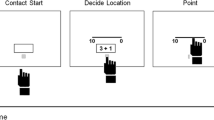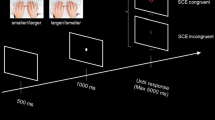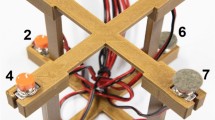Abstract
The SNARC effect reflects the observation that when healthy observers with left-to-right reading habits are asked to compare the magnitude or to judge the parity of numbers, they provide faster reaction times (RT) to small numbers with left-sided responses and faster RTs to large numbers with right-sided responses. In magnitude comparison (MC), right brain damaged patients with left-sided neglect typically show a pathologically enlarged SNARC for large numbers and selective slowing to numbers that are immediately lower than the numerical reference (e.g. 4 for reference 5). This asymmetry has been taken as evidence that small numbers are mentally positioned to the left of the reference and, therefore, are processed less efficiently by patients neglecting the left side of space. In parity judgement (PJ), on the other hand, the size of the SNARC effect is unaffected by neglect. This dissociation is typically attributed to the disturbed explicit processing of number magnitude in MC and preserved implicit processing of magnitude in PJ. Before accepting this interpretation, however, it remains to be investigated whether neglect patients show the same RT pattern that characterizes the performance of healthy participants (i.e. left-side RTs that increase linearly as a function of number magnitude and right-side RTs that decrease linearly as a function of magnitude). Clarifying this point is crucial, because an equally sized SNARC can originate from different RT patterns. Here we demonstrate that the RT pattern of neglect patients during PJ is entirely comparable to those of patients without neglect and healthy controls, while the same neglect patients show selective slowing to numbers that are immediately lower than the numerical reference in MC. These findings suggest the existence of multiple left-to-right spatial representations of number magnitude and provides an explanation of the functional dissociation between MC and PJ tasks.


Similar content being viewed by others
Notes
Tasks order and the order of the response mapping had no influence on the results. This was evaluated with different ANOVA’s with both SNARC effects and the asymmetry index of the distance effect as dependent variables and Task order, Response mapping and Group membership as independent variables. All main effects and interaction effects with Task Order and Response mapping were not significant (all p’s ≥ 0.10).
To ensure that these correlations were not obscured by the group differences that are present in the data, the analyses were repeated on the data of all participants together, but with all the data being normalized to z-scores for each subject group separately (see van Dijck et al. 2012 for a similar procedure). These analyses did again not produce significant results (r = 0.13 and 0.24 with all p’ > 0.193).
References
Abrahamse E, van Dijck J-P, Majerus S, Fias W (2014) Finding the answer in space: the mental whiteboard hypothesis on serial order in working memory. Front Hum Neurosci 8:932. https://doi.org/10.3389/fnhum.2014.00932
Abrahamse E, van Dijck JP, Fias W (2016) How does working memory enable number-induced spatial biases? Front Psychol 7:977
Abrahamse EL, van Dijck JP, Fias W (2017) Grounding verbal working memory: the case of serial order. Curr Dir Psychol Sci 26(5):429–433
Aiello M, Jacquin-Courtois S, Merola S, Ottaviani T, Tomaiuolo F, Bueti D, Doricchi F (2012) No inherent left and right side in human ‘mental number line’: evidence from right brain damage. Brain 135(8):2492–2505
Antoine S, Ranzini M, Dijck JP, Slama H, Bonato M, Tousch A et al (2018) Hemispatialneglect and serial order in verbal working memory. J Neuropsychol. https://doi.org/10.1111/jnp.12145
Azouvi P, Samuel C, Louis-Dreyfus A, Bernati T, Bartolomeo P, Beis JM, De Montety G (2002) Sensitivity of clinical and behavioural tests of spatial neglect after right hemisphere stroke. J Neurol Neurosurg Psychiatry 73(2):160–166
Berti A, Rizzolatti G (1992) Visual processing without awareness: evidence from unilateral neglect. J Cogn Neurosci 4(4):345–351
Binder J, Marshall R, Lazar R, Benjamin J, Mohr JP (1992) Distinct syndromes of hemineglect. Arch Neurol 49(11):1187–1194
Dehaene S (1997) The number sense: how the mind creates mathematics. Oxford University Press, New York
Dehaene S, Bossini S, Giraux P (1993) The mental representation of parity and number magnitude. J Exp Psychol Gen 122(3):371–396
Doricchi F, Incoccia C, Galati G (1997) Influence of figure-ground contrast on the implicit and explicit processing of line drawings in patients with left unilateral neglect. Cogn Neuropsychol 14(4):573–594
Fattorini E, Pinto M, Rotondaro F, Doricchi F (2015) Perceiving numbers does not cause automatic shifts of spatial attention. Cortex 73:298–316
Fattorini E, Pinto M, Merola S, D’ Onofrio M, Doricchi F (2016) On the instability and constraints of the interaction between number representation and spatial attention in healthy humans: a concise review of the literature and new experimental evidence. Prog Brain Res 227:223–256
Fias W, Fischer MH (2005) Spatial representation of number. In: Campbell JID (ed) Handbook of mathematical cognition. Psychology Press, Hove, pp 43–54
Fias W, van Dijck J-P (2016) The temporary nature of number—space interactions. Can J Exp Psychol 70(1):33–40
Fias W, Brysbaert M, Geypens F, d’Ydewalle G (1996) The importance of magnitude information in numerical processing: evidence from the SNARC effect. Math Cogn 2(1):95–110
Fink GR, Marshall JC, Shah NJ, Weiss PH, Halligan PW, Grosse-Ruyken M, Freund HJ (2000) Line bisection judgments implicate right parietal cortex and cerebellum as assessed by fMRI. Neurology 54(6):1324–1331
Fischer MH, Castel AD, Dodd MD, Pratt J (2003) Perceiving numbers causes spatial shifts of attention. Nat Neurosci 6(6):555–556
Gainotti G, De Luca L, Figliozzi F, Doricchi F (2009) The influence of distracters, stimulus duration and hemianopia on first saccade in patients with unilateral neglect. Cortex 45(4):506–516
Gauthier L, Dehaut F, Joanette Y (1989) The bells test—A quantitative and qualitative test for visual neglect. Int J Clin Neuropsychol 11(2):49–54
Gevers W, Ratinckx E, De Baene W, Fias W (2006) Further evidence that the SNARC effect is processed along a dual-route architecture—evidence from the lateralized readiness potential. Exp Psychol 53(1):58–68
Gevers W, Santens S, Dhooge E, Chen Q, Fias W, Verguts T (2010) Verbal-spatial and visuo-spatial coding of number–space interactions. J Exp Psychol Gen 139(1):180–190
Herrera A, Macizo P, Semenza C (2008) The role of working memory in the association between number magnitude and space. Acta Psychologica 128(2):225–237
Hubbard EM, Piazza M, Pinel P, Dehaene S (2005) Interactions between number and space in parietal cortex. Nat Rev Neurosci 6(6):435–448
Jacob S, Nieder A (2008) The ABC of cardinal and ordinal number representations. Trends Cogn Sci 12(2):41–43
Jager G, Postma A (2003) On the hemispheric specialization for categorical and coordinate spatial relations: a review of the current evidence. Neuropsychologia 41(4):504–515
Kim S-Y, Kim M-S, Chun MM (2005) Concurrent working memory load can reduce distraction. Proc Natl Acad Sci USA 102(45):16524–16529
Kosslyn SM (1987) Seeing and imagining in the cerebral hemispheres—a computational approach. Psychol Rev 94(2):148–175
Lavie N, Hirst A, de Fockert JW, Viding A (2004) Load theory of selective attention and cognitive control. J Exp Psychol Gen 133(3):339–354
Lorch RF, Myers JL (1990) Regression-analyses of repeated measures data in cognitive research. J Exp Psychol Learn Mem Cogn 16(1):149–157
Marshall JC, Halligan PW (1988) Blindsight and insight in visuo-spatial neglect. Nature 336(6201):766
Pinto M, Fattorini E, Lasaponara S, D’Onofrio M, Fortunato G, Doricchi F (2018) Visualising numerals: a ERPs study with the attentional SNARC task. Cortex 101:1–15
Priftis K, Zorzi M, Meneghello F, Marenzi R, Umilta C (2006) Explicit versus implicit processing of representational space in neglect: dissociations in accessing the mental number line. J Cogn Neurosci 18(4):680–688
Proctor RW, Cho YS (2006) Polarity correspondence: a general principle for performance of speeded binary classification tasks. Psychol Bull 132(3):416–442
Rorden C, Karnath HO (2010) A simple measure of neglect severity. Neuropsychologia 48(9):2758–2763
Rossetti Y, Jacquin-Courtois S, Aiello M, Ishihara M, Brozzoli C, Doricchi F (2011) Neglect “around the clock”: dissociating number and spatial neglect in right brain damage. In: Dehaene S, Brannon EM (eds) Space, time and number in the brain: Searching for the foundations of mathematical thought. Academic Press, Burlington, MA, pp 149–173
Schwarz W, Keus IM (2004) Moving the eyes along the mental number line: comparing SNARC effects with saccadic and manual responses. Percept Psychophys 66(4):651–664
Van Opstal F, Gevers W, De Moor W, Verguts T (2008) Dissecting the symbolic distance effect: comparison and priming effects in numerical and nonnumerical orders. Psychon Bull Rev 15(2):419–425
van Dijck J-P, Gevers W, Fias W (2009) Numbers are associated with different types of spatial information depending on the task. Cognition 113(2):248–253
van Dijck J-P, Gevers W, Lafosse C, Fias W (2012) The heterogeneous nature of number–space interactions. Front Hum Neurosci 5:182
van Dijck JP, Ginsburg V, Girelli L, Gevers W (2015) Linking numbers to space: from themental number line towards a hybrid account. In: Cohen Kadosh R, Dowker A (eds) The Oxford handbook of mathematical cognition. Oxford University Press, Oxford, UK, pp 89–105
Verdon V, Schwartz S, Lovblad KO, Hauert CA, Vuilleumier P (2009) Neuroanatomy of hemispatial neglect and its functional components: a study using voxel-based lesion-symptom mapping. Brain 133(3):880–894
Vuilleumier P, Ortigue S, Brugger P (2004) The number space and neglect. Cortex 40(2):399–410
Zorzi M, Bonato M, Treccani B, Scalambrin G, Marenzi R, Priftis K (2012) Neglect impairs explicit processing of the mental number line. Front Hum Neurosci 6:125
Acknowledgements
We would like to thank Mario Pinto and Michelle Pellegrino for their help in testing additional patients.
Author information
Authors and Affiliations
Corresponding author
Additional information
Publisher’s Note
Springer Nature remains neutral with regard to jurisdictional claims in published maps and institutional affiliations.
Rights and permissions
About this article
Cite this article
van Dijck, JP., Doricchi, F. Multiple left-to-right spatial representations of number magnitudes? Evidence from left spatial neglect. Exp Brain Res 237, 1031–1043 (2019). https://doi.org/10.1007/s00221-019-05483-5
Received:
Accepted:
Published:
Issue Date:
DOI: https://doi.org/10.1007/s00221-019-05483-5




